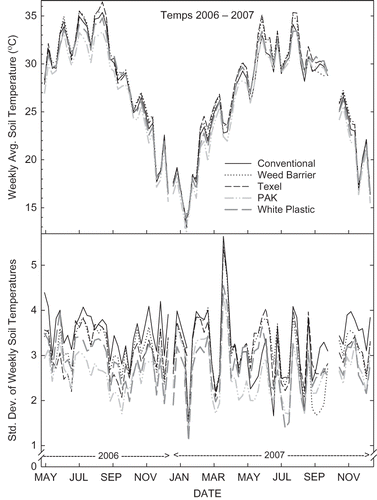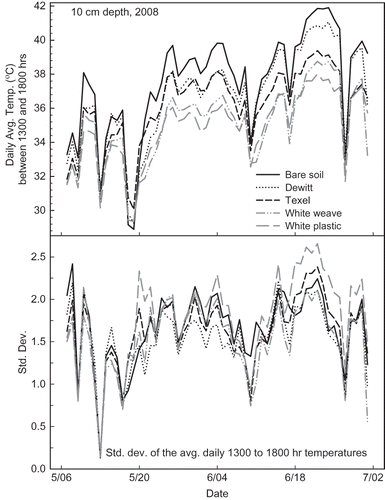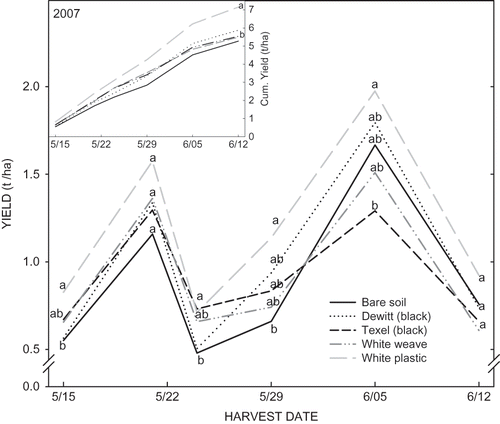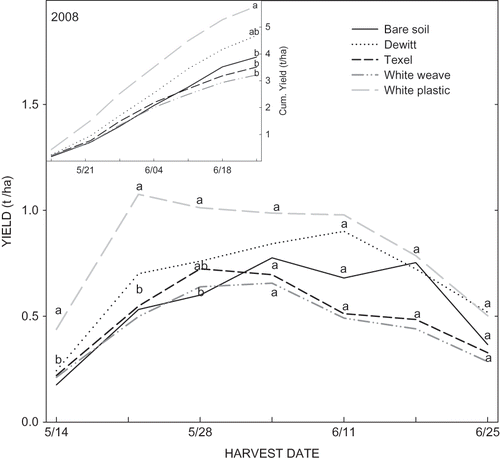Abstract
Weed control in blackberries (Rubus spp.) is a serious problem for organic producers and those who wish to reduce their reliance on herbicides. Three landscape fabrics and one industrial grade white on black plastic were evaluated for weed control in conjuction with newly planted ‘Kiowa’ root cuttings in Feb. 2006 at a site near Monte Alto, Texas (26°N Lat.). In the no-fabric treatment, weeds were controlled mechanically by hand. The reflectant white plastic and weave weed barriers reduced mid-summer soil temperatures at 10 cm and reduced the magnitude in soil temperature fluctuation. Field plant vigor and plant height measured in 2007 (only) were improved by use of weed barriers. The time required for plot weed removal was shortest for white plastic and longest for bare soil. White plastic improved the average cumulative season yields in both years (6.46 t/ha) compared to yields from plants grown in bare soil (4.58 t/ha), P = 0.003, and also when contrasted against all other weed control methods (P = 0.0003). In 2007, fruit from bare soil plants showed the greatest decline in average fruit size during the picking season. In 2007, fruit from plants grown in bare soil were lowest in soluble solids and sugar:acid ratio compared to fruit from weed barrier treatments. Similar, though non-significant, fruit quality trends existed in 2008 harvested fruit. In both years, fruit grown over white plastic had the highest mean soluble solids concentration (11.3%) compared to bare ground-grown fruit (9.8%).
INTRODUCTION
About 7,160 ha of blackberries (Rubus spp.) are grown in North America (CitationStrik et al., 2007). Driving the popularity and consumption of blackberries is their reputation as an excellent source of antioxidants (CitationPellegrini, et al., 2003; CitationFan-Chiang and Wrolstad, 2005) and their anti-cancer potential (CitationDing et al., 2006; CitationFeng et al., 2007). Several cultivars have been reported to be adapted to south Texas (CitationLukefahr and Scott, 1994).
Currently in California, chemical weed control costs for blackberry production are upwards of $1,700 USD per hectare (CitationCarol, 2008). In the sub-tropical Rio Grande Valley, weeds are a major cultural pest, particularly because of the long growing season. Weed control by non-chemical methods would be highly desirable from both an environmental and organic market standpoint, but few studies have demonstrated their use in brambles (CitationMakus, 2007, Citation2010) or have been casually mentioned in non-refereed sources. Numerous landscape fabrics, though expensive, are effective weed barriers. Some permeable membrane row covers have been reported to allow for the infiltration of nutrients from compost/manures into the soil and may be useful in organic production systems (CitationZibilske, 2010). Because of the high value of the fruit and perennial nature of blackberries, weed barriers having several years of field utility would be desirable for weed control in both blackberries and similarly-grown cane fruits. The objective of this study was to evaluate several of these fabric materials and an industrial strength white plastic for the control of weeds during the first two fruiting seasons of the thorny, erect, cultivar ‘Kiowa’.
MATERIALS AND METHODS
Four materials were tested: DeWitt (BWI, Shullenberg, TX, USA) is a black polypropylene with polyester blend; Texel (BWI) is a black (gray on the other side) polypropylene/polyester permeable membrane; a white-on-black UV-stabilized polyethylene weave (PAK Unlimited, Cornelia, GA, USA); and a nylon-reinforced white on black plastic (T-65, Reef Industries, Houston, TX, USA). The first three materials allow air, water, and vapor exchange, while the fourth does not. A soil only treatment was included, which was kept weed-free mechanically at monthly intervals. Objective color of the materials (lightness, chroma, and hue), including that of the bare soil at two soil moisture conditions, was determined with a Minolta Model 200 Chroma meter (Konica Minolta Sensing Americas, Inc., Ramsey, NJ, USA). The planting site was located near Monte Alto, Texas (Lat. 26° 26′ N, Long. 97° 58′ W) on a Hargill fine sandy loam (fine-loamy, mixed, hyperthermic Udic Paleustolls) soil.
A single 91-m row was rotovated to 15 cm, a 20 mil bi-wall irrigation tape placed 46 cm deep, and two similar 0.6 m wide strips of each barrier material placed parallel to and 23 cm from the row center to allow for the blackberry roots (15 to 20 cm in length) to be planted 5 cm deep and 0.6 m apart in the-row. Fabric installation and planting were done on Feb. 2 and Feb. 15, 2006, respectively. After shoot emergence, 10 cm of bagasse were placed over the 0.5-m-wide bare soil area between the weed barrier treatments on March 29. Each 3.6-m experimental plot consisted of six plants, and each of the five weed control methods were replicated five times as a randomized complete block design. A 3-m width of grass sod was present on either side of the 25 plots.
In replication two, thermocouples were placed on May 9, 2006 on the south side of the row and in the middle of the respective weed barrier and corresponding soil only location. The thermocouples were set at a depth of 10 cm and temperatures measured every 60 s and averaged at the end of the hourly interval with a CR-10 data logger (CSI, Logan, UT, USA) until July 14, 2008. Ten 20-cm long EC-20 moisture sensors (Decagon Devices, Pullman, WA, USA) were installed vertically from the soil surface in the center of each treatment in replications two and four on July 7 and soil water content (0 to 20 cm depth) was measured periodically six times between July 18, 2006 and Jan. 10, 2007.
On June 20, 2006, 22 kg N/ha (as 15‐35‐15) was applied to all treatments through the irrigation system. On Aug. 2, 0.62 kg of S.T.E.M. (Scotts, Marysville, OH, USA) soluble trace elements was added. On Apr. 6, 2007 and Apr. 10, 2008, at initial flowering, 1 t of poultry litter (56 kg N/ha equivalent) was applied. On Aug. 8, 2007 and June 25, 2008, 1.5 kg of S.T.E.M. and 22 kg N/ha (as ammonium nitrate) were added through the irrigation system. Average plant height and plot vigor (scale: 1 = poor to 5 = highest vigor) ratings were made on Oct. 17, 2006 and June 22, 2007, respectively. Primocane pruning cuts were begun in fall 2007 to keep plant height to approximately 75 to 90 cm, maintain plot integrity, and to remove trailing type cane growth throughout the growing season. Therefore, no further data was taken on plant height after 2007.
In 2007, fruit was harvested on May 15, May 21, May 24, May 29, June 5, and June 12 from the same 1.8 m of row in each plot. Harvested fruit were placed into 1-L clam-shell plastic containers and plot yield was determined. On May 11 and June 18, 25 fruits from the adjacent unsampled area within each plot were collected to determine average fruit weight and to measure fruit quality parameters. After weighing, fruits were stored at −20°C until used. In 2008, fruit was harvested on May 12, May 20, May 26, June 2, June 9, June 16, and June 23 from the same 1.8 m of row as was harvested in 2007 for yield determination. On May 13 and June 17, 25 fruit per plot were collected as in 2007 for average fruit weight determination and to measure fruit quality parameters. Fruit was stored at −20°C until analyzed.
Fruit Quality
Approximately 70 g of fruit from early and late harvests in each year were blended, then vacuum filtered through a Whatman #3 pre-filter, followed by a Whatman #1 filter for 10 min. The filtrate volume was measured, then subsamples were used for soluble solids determination (Atago PR-32α digital refractometer; Atago USA, Inc., Kirland, WA, USA), initial pH, and titratable acidity (Mettler DL 12 titrator; Mettler-Toledo, Columbus, OH, USA).
Data were analyzed by SAS Versions 8.2 and 9.1 using the PROC GLM and MIXED procedures (SAS Institute, Cary, NC, USA). The Ryan-Einot-Gabriel-Welsch multiple range test was used for mean comparisons at the appropriate probability levels shown in the tables and –4. Differences between response means in Tables were tested using the PDIFF option of the LSMEANS statement of PROC GLM. Single degree orthogonal contrasts were made between no-fabric and all fabrics and between white plastic and all ‘other’ treatments.
FIGURE 1 Mean weekly soil temperatures and their mean standard deviations at 10 cm beneath the four weed barriers and bare soil in replication two from the week beginning May 12, 2006 and ending Dec. 30, 2007.

TABLE 1 Cost, Durability After Two Seasons Use, and Differences in Initial Fabric Lightness (‘L’ Values) (P < 0.01) of Materials and Soil Used in the 2006 Planting
TABLE 2 Weed Removal Time (in s) to Weed 6.7 m2 Plots on Nov. 9, 2007 and July 11, 2008; and Plant Height and Vigor on Oct. 17, 2006 and June 22, 2007
TABLE 3 Raw Product Quality of Blackberry Fruits as Affected by Weed Barrier Method, Harvest Date (Early and Late), and Year (2007 and 2008)
RESULTS AND DISCUSSION
The initial costs of the fabric materials (FOB factory) are given in along with the objective color property ‘L’ (lightness) of these materials. Other properties, such as ‘chroma’ (color intensity) and ‘hue’ (color), have been reported elsewhere (CitationMakus, 2007). The ‘L’ value is the most important attribute in terms of soil cooling and light reflectance into the canopy. White weave and white plastic had the highest ‘L’ values. Soil ‘L’ values, which were averaged over both wet and dry soil, were higher than the Dewitt (black), but lower than the Texel (black) fabrics. All fabrics, except white weave, were durable enough to last at least one growing season (). The white weave began decomposing after about 1 year in the field. The local erythemal (UV) index for the area is typically 10–11 during the summer months. In a companion study, the Dewitt black fabric and white plastic materials have withstood UV degradation after 2 years in the field (CitationMakus and Jifon, 2007) and had maintained their original integrity for 7 years, at which time that experiment was terminated. The use of the bagasse-mulch strip suppressed, but did not eliminate all weed growth. Projected barrier material installation costs would be comparable to that of laying two double 0.6 m rows of plastic, which in this case, were on 3.65 m row centers. Manual weed removal times, WRT, (in seconds) between white plastic and bare ground treatments were reduced by a factor 3.1 X in 2007 and by 4.6 X in 2008 (). Most other barriers were effective in reducing WRT in both years except the PAK white weave, which began deteriorating during the first season. The increased WRT between years can be attributed to loss of bagasse mulch after two seasons, higher seasonal weed pressure when the WRT were made in 2008, and a longer interval between weed removal in 2008. It will require either a seasonal application of a herbicide(s) or a renewal application of about 4.6 m3 per 100 m row of bagasse every other year to maintain ‘clean’ row centers with this management system.
Rainfall for the months of November through June for 2007 and 2008 were 264 and 120 mm, respectively. The experimental plots received 325 and 303 mm of supplemental trickle irrigation between March and June (inclusive) in 2007 and 2008, respectively. Mean monthly air temperature for the months of April, May, and June for 2007 and 2008 were 21.86, 25.52, and 28.48°C, and 23.65, 27.41, and 28.88°C, respectively. Based on these data, 2008 was a hotter and drier year and supplemental irrigations in 2008 may not have been adequate.
In 2006, mean weekly mid-summer soil temperatures at 10 cm were reduced by the lighter textured fabrics, white weave and white plastic, and increased by the Dewitt and Texel fabrics compared to the bare soil temperatures (). This temperature pattern was less pronounced in 2007, particularly as the white weave fabric began to deteriorate and the white plastic became covered with soil (). In 2006, mean mid-summer weekly temperature deviations were reduced by fabrics, particularly the light textured fabrics, compared to those of the bare soil. Differences in mean weekly standard deviations became less apparent by mid-2007. Daily soil temperatures measured between 1300 and 1800 hr during the 2008 harvest season were reduced by the lighter weed barriers at the 10 cm depth (). Plotting mid-day hourly soil temperatures illustrates the dramatic effect white materials have on reducing afternoon soil temperatures. Surprisingly, the greatest afternoon average soil temperature fluxuation or deviation was under the lighter plastics. Cane growth over the thermocouple placement locations were not always removed in a timely fashion, perhaps contributing to measurement inaccuracies during parts of the growing season. In a companion experiment at the same site in 2006, mid-day surface temperatures in a newly established peach orchard containing white plastic, bare soil, and Dewitt fabric weed barriers were 55.3, 57.8, and 70.0°C, respectively; and a bagasse mulch, by itself, had a noon-day temperature of 72.8°C (CitationMakus and Jifon, 2007). Although weed species were not studied, dark fabrics appeared to be more effective in lowering the incidence of broadleaf weeds, perhaps by thermal desiccation when surface temperatures approached or exceeded 70°C.
FIGURE 2 Mean daily soil temperatures between 1,300 and 1,600 hr and their corresponding standard deviations at 10 cm beneath the four weed barriers and bare soil in replication two for the period beginning one week before through one week after the 2008 picking season.

Soil water content in the 0 to 20 cm zone, which was measured six times between July 2006 and Jan. 2007, showed no consistent pattern between treatments (data not shown). An unpublished greenhouse study with newly rooted ‘Kiowa’ cuttings in 2008 suggested that early plant growth was benefited by row covers and water conservation, but in time these plants used more water between irrigations as they became larger than control plants (see ).
Phenological development, based upon plant height (2006) and vigor rating (2007), was different between the soil-only and fabric-grown blackberry plants (). There were date but no date X fabric interactions. Hand weeding removal time per plot was significantly reduced with the use of white plastic and the Dewitt weed barrier (). However, as the less durable weed barriers began to break down in 2008, differences were less apparent or nonexistent between these materials and the bare ground treatment. Some grasses, perhaps because they can spread by rhizomes, were more of a problem in the weave fabrics, compared to the opaque white plastic, where weeds were encountered only in the areas without coverings.
Yields
There were significant (P = 0.0001) fruit yield differences between years. In 2007, the first fruiting year, treatment yield differences occurred on four of the six harvest dates (). On every harvest date, blackberries grown over white plastic weed barriers had the highest mean harvest weights. Bare ground plots had the lowest mean yields for the first four harvests. The cumulative season yield was significantly higher (P < 0.02) from blackberries grown on white plastic compared to all other treatments (, inset). The 2007 experiment-wide average yield was 5.8 t/ha. Shorter harvest intervals would have improved total yields across all treatments. Mean fruit weight was not affected by fabric use at the beginning of the picking season (). Fruit from plants grown without fabric had the lowest mean berry weights (P < 0.06) at the end of the season and had the lowest (P < 0.07) average season weights. Season weight reduction was also greatest in blackberries grown without fabrics (P < 0.12), which declined by 36% between the first and last harvest ().
In 2008, white plastic improved fruit yield at the first two harvests over all other treatments and resulted in the numerically highest yield in six of the seven harvests (). The cumulative season yield of fruit grown under white plastic was significantly higher (P = 0.05) than all other treatments except the Dewitt black fabric (see inset). There were no treatment X year interactions, but the degradation of Texel and the white weave may have reduced the yield of plants grown with these materials relative to the previous growing season. The white plastic treatment contrasted against all other treatments in both 2007 and 2008 and produced significantly more fruit (P = 0.0003). Normally, one would have expected higher yields in the second fruiting season, based on previous blackberry research in South Texas (CitationLukefahr and Scott, 1994), but lack of late fall and early season moisture and higher monthly air temperatures may have contributed to the lower 2008 yield results in addition to lateral (between row) growth restriction due to the weed barriers.
Fruit Quality
There were year differences in average fruit weight, soluble solids (%), initial pH, titratable acidity (as % malate), and the sugar:acid ratio (). In 2007, average fruit weight declined by 1.5 g per berry between early and late harvests. Blackberry fruit grown without the benefit of weed barrier materials were consistently the smallest in size at both harvests. Weed barrier use improved fruit SS (%) at both harvests, with white plastic providing the highest improvement compared to bare ground-grown fruit. Initial fruit pH values were lower (more acidic) early in the season. The white plastic-grown fruit had the highest pH at both harvests, but Texel-grown fruit were lowest in pH at the early harvest, then comparable to other treatments at the late harvest, giving rise to the pH × Date interaction. Malate (%) values between treatments were inverse to those of fruit pH, but were not significantly different between treatments. Malate (%) fruit levels were higher at the early harvest (1.3 vs. 1.1%). The sugar:acid ratio was improved 36% when white plastic was used for weed control, compared to bare ground. When bare ground-grown fruit quality attributes were contrasted to all other weed barrier treatments, bare ground-grown fruit were inferior (lower) in fruit weight, soluble solids, and sugar:acid ratio. In 2008, most fruit quality attributes between treatments were similar, although white plastic-grown fruit had the highest fruit SS (%) and bare ground-grown fruit had the lowest pH when contrasted against all other treatments. Fruit grown with the white weed barriers declined in average berry weight at the late harvest date compared to the other weed barriers and bare ground treatment giving rise to the Date X Treatment interaction (P = 0.03). As in 2007-grown fruit, pH levels were lowest (more acidic) and malate (%) levels were highest in early season fruit. In 2008, the sugar:acid ratio was significantly higher in late season-grown fruit; average fruit weights were not consistent between treatments and season.
Malic acid is the major organic acid in blackberries (CitationWhiting, 1957). The experiment-wise malic acid levels reported for the first harvest date in 2007 were identical (1.32 vs. 1.3% ± 0.1) to those reported by CitationKafkas et al. (2006) for ‘Navaho’, which was released from the same breeding program as was ‘Kiowa’ (CitationClark, 1999).
In conclusion, weed barriers effectively reduced the time necessary to manually control weeds during the first two fruiting seasons in ‘Kiowa’ blackberries by as much as 4.5-fold that of a conventional bare ground planting. In both 2007 and 2008, the white plastic weed barrier improved not only total yields compared to all other barriers and bare soil (control), but fruit SS (%) and fruit sugar:acid ratio (2007 only). Soil temperatures (at 10 cm) and their weekly standard deviation were reduced by the more reflective weed barriers. Barriers had little measurable influence on soil water content at 0 to 20 cm but tended to promote more vigorous plant growth and, thus, subsequent yield. The white plastic and Dewitt black fabric provided excellent durability, but were the most expensive. The use of fabric barriers and other cultural modification techniques may reduce or eliminate the need for conventional herbicides and extend blackberry fruit production to warmer latitudes. Although not tested, added benefits to the use of weed barriers should be a reduction in wind-blown soil loss and organic matter photoxidation, which is common in semi-arid areas, such as west and south Texas.
ACKNOWLEDGMENTS
Technical assistance of C. Salinas is gratefully acknowledged in addition to A. Scott of Rio Farms, Monte Alto, TX who provided the site. Mention of trade names or commercial products in the article is solely for providing specific information and does not imply recommendation or endorsement by the U.S. Department of Agriculture.
Notes
This article not subject to US copyright law.
LITERATURE CITED
- Carol, B. 2008. Berry growers face unique weed control challenges. Western Farm Press. http://westernfarmpress.com/berry-growers-face-unique-weed-control-challenges (http://westernfarmpress.com/berry-growers-face-unique-weed-control-challenges) (Accessed: 11 March 2008 ).
- Clark , J.R. 1999 . The blackberry breeding program at the University of Arkansas: Thirty-plus years of progress and developments for the future. In: G. McGregor, H. Hall, and G. Langford (eds.). Proceedings of the 7th International Rubus-Ribes Symposium . Acta Hort. , 505 : 73 – 77 .
- Ding , M. , Feng , R. , Wang , S.Y. , Bowman , L. , Lu , Y. , Qlan , Y. , Castranova , V. , Jiang , B.H. and Shi , X. 2006 . Cyanidin-3-glucoside, a natural product derived from blackberry, exhibits chemopreventive and chemotherapeutic activity . J. Biol. Chem. , 181 : 17359 – 17368 .
- Fan-Chiang , H-J. and Wrolstad , R.E. 2005 . Anthocyanin pigment composition of blackberries . J. Food Sci. , 70 : 198 – 202 .
- Feng , R. , Ni , H-M. , Wang , S.Y. , Tourkova , I.L. , Shurin , M.R. , Harada , H. and Yin , X-M. 2007 . Cyanidin-3-rutinoside, a natural polyphenol antioxidant, selectively kills leukemic cells by induction of oxidative stress . J. Biol. Chem. , 282 : 13468 – 13476 .
- Kafkas , E. , Kosar , M. , Turemis , N. and Baser , K.H.C. 2006 . Analysis of sugars, organic acids and vitamin C contents of blackberry genotypes from Turkey . Food Chem. , 97 : 733 – 736 .
- Lukefahr , M.J. and Scott , A.W. Jr. 1994 . Blackberry evaluation and production in the Rio GrandeValley . Subtropical Plant Sci. , 46 : 13 – 15 .
- Makus , D.J. 2010 . Weed control and canopy light management in blackberries. Intl . J. Fruit Sci. , 10 : 177 – 186 .
- Makus , D.J. 2007 . Use of fabric and plastic barriers to control weeds in blackberries . Subtropical Plant Sci. , 59 : 95 – 103 .
- Makus , D.J. and Jifon , J. 2007 . Impact of weed barriers on newly planted peach trees . HortScience , 42 : 456 – 457 . (Abstract).
- Pellegrini , N. , Serafini , M. , Colombi , B. , Del Rio , D. , Salvatore , S. , Bianchi , M. and Brigenti , F. 2003 . Total antioxidant capacity of plant food, beverages and oils consumed in Italy assessed by three different in vitro assays . J. Nutr. , 133 : 2812 – 2819 .
- Strik , B.C. , Clark , J.R. , Finn , C.E. and Banados , M.P. 2007 . Worldwide blackberry production . HortTechnology , 17 : 205 – 213 .
- Whiting , G.C. 1957 . The non-volatile organic acids of some berry fruits . J. Sci. Food Agr. , 9 : 244 – 48 .
- Zibilske , L.M. 2010 . Permeability of fabric ground covers to organically-derived nutrients. Intl . J. Fruit Sci. , 10 : 109 – 122 .

